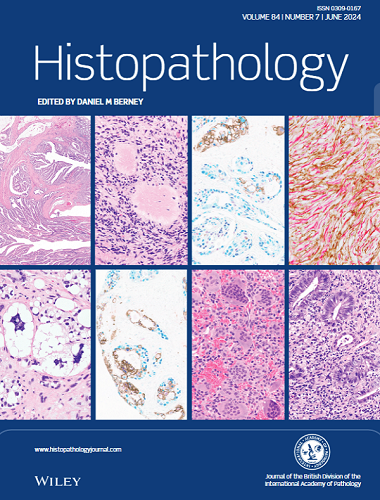Serous-like breast carcinomas: immunophenotypic, genetic, and clinicopathologic characterization of a morphologically distinct group of tumours
Abstract
Aims
Unusual morphologic patterns of breast carcinomas can raise diagnostic consideration for metastasis or special breast cancer subtypes with management implications. We describe rare invasive breast cancers that mimic serous carcinoma of the gynaecologic tract (serous-like breast carcinomas, SLBC) and characterize their clinicopathologic, immunophenotypic, and genetic features.
Methods and Results
All patients were female (n = 15, median age 49 years) without a history of gynaecologic malignancy. SLBC were characterized histologically by angulated, branched, sometimes anastomosing glands with micropapillary and/or pseudopapillary luminal projections in desmoplastic stroma. Most SLBC were triple-negative (TN, n = 10) or HER2-positive (n = 2) and grade 2 or 3, while some were oestrogen receptor (ER) low-positive/HER2-negative and low-grade (n = 3). CK5/6 was positive irrespective of grade or receptor status (10/10). All SLBC expressed GATA3 (14/15), TRPS1 (7/7), and/or mammaglobin (4/13). SOX10 was positive in most TN (9/10) and all ER low-positive (3/3) cases, but negative in HER2-positive tumours. WT1 was universally negative, and PAX8 was focal in one mammaglobin-positive tumour. All ER-negative SLBC were p53-aberrant and 9/11 were p16-aberrant, whereas ER-positive tumours were wildtype for both markers (3/3). TP53 was the only frequently mutated gene, altered in all ER-negative (10/10) but no ER-positive (0/4) tumours. Clinical behaviour was variable. Only 1/6 patients achieved pathologic complete response to neoadjuvant chemotherapy.
Conclusion
SLBC is a rare morphologic pattern of invasive breast carcinoma that mimics metastatic serous gynaecologic carcinoma, a potential diagnostic pitfall. SLBC are heterogeneous with respect to grade, receptor profile, and oncogenic driver alterations, without specific genetic underpinnings identified. Additional studies are warranted to further evaluate the clinical behaviour of these tumours.


 求助内容:
求助内容: 应助结果提醒方式:
应助结果提醒方式:


